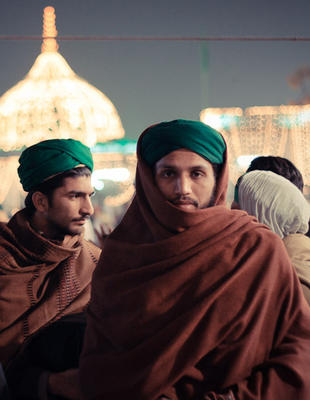Sufism: Seeking God

Sufism [taṣawwuf] is not a separate sect of Islam, but rather a stream of interpretation emphasizing the interior path of mystical love and knowledge of God. A tradition describes the Prophet’s spiritual journey, the mi‘rāj, in which a celestial steed carried him to Jerusalem, from where he ascended into the highest heavens and came face to face with God. Taking the mi‘rāj as an archetype of the spiritual journey, Sufism began as an imitation of Muhammad’s simplicity and spiritual life in a time when the Umayyad caliphs (661–750) lived extravagantly. Many attribute the origins of the name “Sufi” to the coarse wool [ṣūf] garment worn by early ascetics. Others suggest the term derives from the Arabic word for purity [ṣafā’].
Rabi’ah al-‘Adawiyya (d. 801), a woman from the city of Basra, Iraq, is remembered as an important early figure in this tradition whose mystical devotion and love of God were exemplary. There are stories of her walking through the streets of Basra carrying a torch in one hand and a bucket of water in the other, declaring: “I want to pour water into Hell and set fire to Paradise so that these two veils disappear and nobody worships God out of fear of Hell or hope for Paradise, but only for the sake of His Eternal Beauty.” [1]
Sufi rituals focus on the remembrance of God, or dhikru ’Llāh. Dhikr has a variety of expressions, including the chanting of God’s Names and short surahs from the Quran, but also music and dancing. Many of these practices are communal; the term “whirling dervish” for example refers to a member of the Mevlevi Order, followers of the Sufi saint Jalal al-Din Rumi (d. 1273), who perform one such communal ritual, which involves a spinning dance combined with inner concentration on the presence of God. Sufism infuses Islam with a spirit of deep devotion and inner piety. Though the majority of Sufis throughout history have followed the sharī‘ah with dedication, many Sufis also offer a critique of the emphasis on the legalistic aspects of Islam alone—which Rumi argued were empty without spiritual reflection, as demonstrated by these lines from the his widely influential poem, The Mathnawī:
“He observes obedience and fasting and prayer
And devotions and almsgiving and so on
Yet never feels the least expansion of soul.
He performs the devotions and acts enjoined by the law
Yet derives not an atom of relish from them.” [2]Various orders (sg. ṭ̣arīqah) developed around prominent Sufi teachers from the twelfth century onward, offering paths and guides for the soul’s journey to God, which reflects the Prophet’s celestial journey, some emphasizing austere discipline while others encouraging ecstatic devotional practices. Within the spiritual life of the orders, the role of the spiritual master (shaykh in Arabic, pīr in Persian) has always been paramount, as he or she would complement the method and doctrines of the order with individually tailored advice, based on insight into the particular state of the disciple’s soul. Strict adherence to the instructions of the master was the norm, as the disciple endeavored to overcome the limitations and desires of his or her ego and totally submit to God.
The orders also became important ways for Muslims to organize themselves in society, establishing hostels (zāwiyah in Arabic, khānaqah in Persian) throughout the Muslim world, and taught their neighbors the way of devotion to God. It was through the influence of either particular charismatic Sufi masters and their disciples or the general influence of Sufism on culture that Islam spread throughout East and West Africa, South and Southeast Asia.
Today some Muslims challenge the legitimacy of Sufi beliefs and practices, such as the level of authority given to Sufi masters, and claim that they are not true representations of Islam, but rather “innovations” that deviate from the original teachings of Muhammad and his companions. Sufism, however, continues to appeal to many Muslims throughout the world, to bring new Muslims into the ummah, to shape Islamic intellectual traditions, and to provide a vehicle for popular expressions of Islamic devotion. Many Sufis perform pilgrimage to shrines of Sufi masters, praying for intercession, aid and closeness to God. This has been controversial to some non-Sufi Muslims who take issue with the idea of requesting anything from the physically deceased. Such disputes regarding Sufism represent one dimension of the internal diversity of the tradition.
[1] Annemarie Schimmel, Islam: An Introduction (Albany: State University of New York Press, 1992), p. 105.
[2] The Masnawi, translation by E.N. Whinfield (1898) (New York: Cosimo Classics, 2010), p. 104.
←Shi’a and Sunni Interpretations
→Shari’ah: Following the Straight Path
Image Credits:
Usman Malik, “Sufi gathering in Lahore“, Lahore, Pakistan (2012), (CC BY-NC 2.0)
Mladifilosof, “Whirling dervishes at Mausoleum,” Mevlevi dervishes at the tomb of Jalal al-Din Rumi in Konya, Turkey (2006), (CC BY-SA 3.0)See also: Islam
